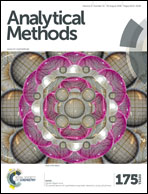Optimization of ultrasonic-assisted extraction of higher fatty acids in grape berries (seed-free fruit sections)
Abstract
This study was conducted to optimize the ultrasonic-assisted extraction (UAE) of higher fatty acids (with aliphatic tails more than or equal to 14 carbons) in grape berries (seed-free fruit sections). Preliminary experiments showed that the extraction solvent, extraction duration, extraction temperature and ultrasound power were the main influencing factors in terms of UAE efficiency. Orthogonal testing was also performed to further investigate the optimal UAE parameters. The results showed that the extraction solvent n-hexane (25 mL, extraction 4 times), extraction duration (30 min), temperature (45 °C) and ultrasound power (396 W) were the optimal conditions. The optimized method took less time and caused less degradation of α-linolenic acid from grape berries compared to traditional Soxhlet extraction. The linearity of this method covered a wide concentration range and the correlation coefficients were satisfactory (99.22% < R2 < 99.88%). The limits of detection (signal/noise = 3), which ranged from 0.002 mg mL−1 to 0.005 mg mL−1, were sufficiently low to meet the detection requirements. The relative standard deviations (RSDs) of the method ranged from 2.10% to 8.50% and the recoveries of the method at 0.5-, 1- and 2-times addition levels were in the range of 81.93% to 118.82%.


 Please wait while we load your content...
Please wait while we load your content...